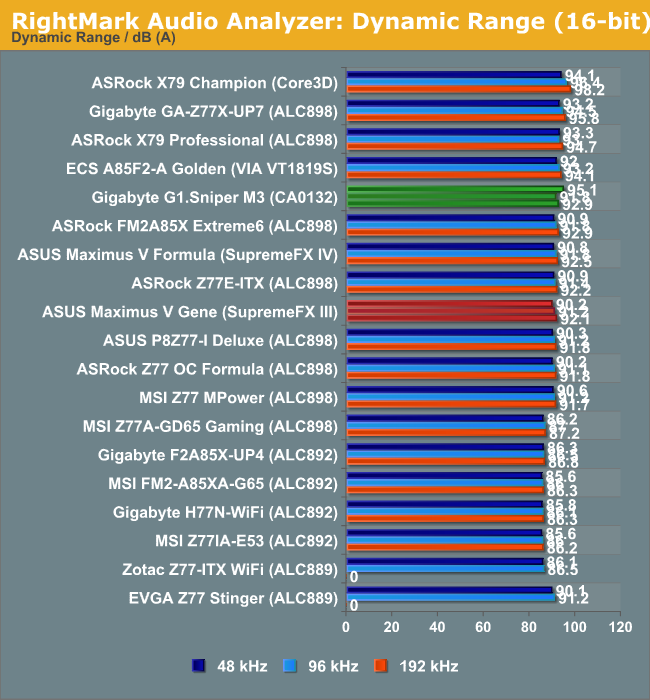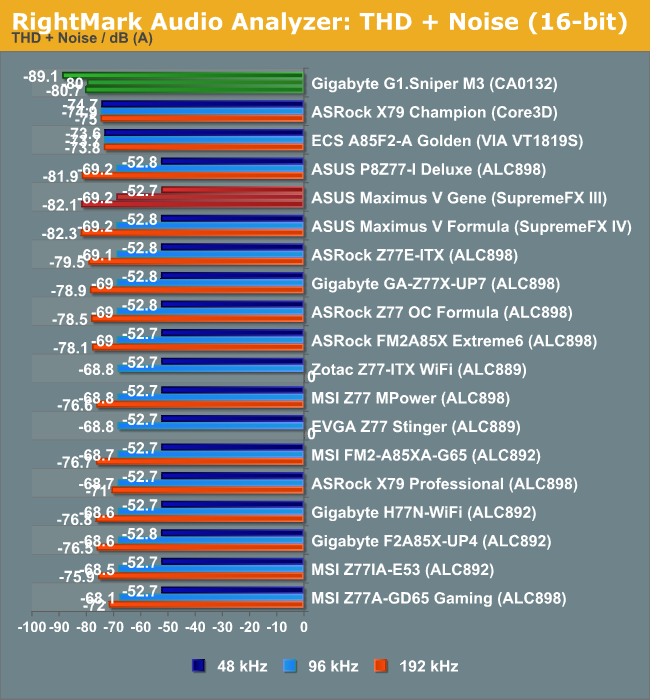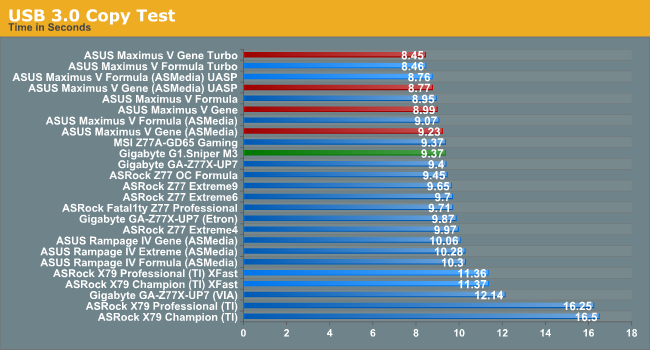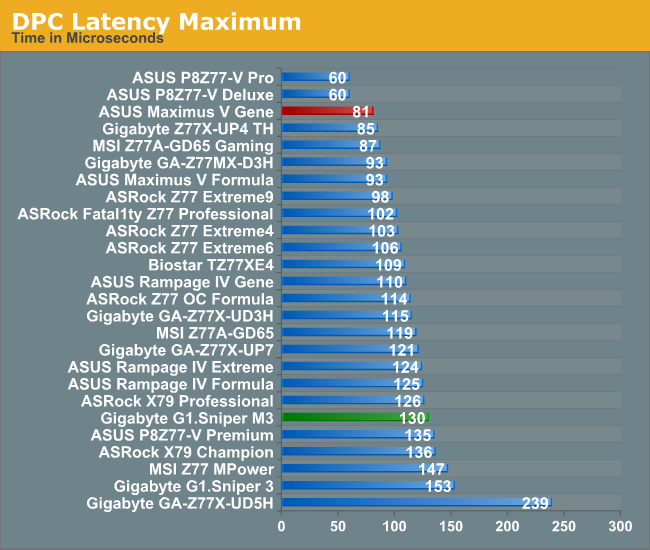ASUS Maximus V Gene vs. Gigabyte G1.Sniper M3 Review
by Ian Cutress on May 13, 2013 10:00 AM EST- Posted in
- Motherboards
- Gigabyte
- Asus
- MicroATX
- Z77
Rightmark Audio Analyzer 6.2.5
In part due to reader requests, we are pleased to include Rightmark Audio Analyzer results in our benchmark suite. The premise behind Rightmark:AA is to test the input and output of the audio system to determine noise levels, range, harmonic distortion, stereo crosstalk and so forth. Rightmark:AA should indicate how well the sound system is built and isolated from electrical interference (either internally or externally). For this test we connect the Line Out to the Line In using a short six inch 3.5mm to 3.5mm high-quality jack, turn the OS volume to 100%, and run the Rightmark default test suite at 48 kHz, 96 kHz and 192 kHz. We look specifically at the Dynamic Range of the audio codec used on board, as well as the Total Harmonic Distortion + Noise.


In our limited audio test, the G1.Sniper M3 does come out better off than the SupremeFX III, but in order to get there we had to disable the majority of the add-in software that comes with the Gigabyte in order to get the test to even run at anything more than 48 kHz.
USB 3.0 Backup
For this benchmark, we run CrystalDiskMark to determine the ideal sequential read and write speeds for the USB port using our 240 GB OCZ Vertex3 SSD with a SATA 6 Gbps to USB 3.0 converter. Then we transfer a set size of files from the SSD to the USB drive using DiskBench, which monitors the time taken to transfer. The files transferred are a 1.52 GB set of 2867 files across 320 folders – 95% of these files are small typical website files, and the rest (90% of the size) are the videos used in the WinRAR test.

The Maximus V Gene is ahead in terms of USB 2.0 speeds and efficiency.

Similarly in USB 3.0, the ASUS takes the lead. As the ASUS has USB 3.0 Boost and an ASMedia controller for extra USB 3.0 ports, we can see that any setting hits the high echelons of our USB 3.0 test. It is worth noting that ASUS have the top eight spots in our most recent USB 3.0 data.
DPC Latency
Deferred Procedure Call latency is a way in which Windows handles interrupt servicing. In order to wait for a processor to acknowledge the request, the system will queue all interrupt requests by priority. Critical interrupts will be handled as soon as possible, whereas lesser priority requests, such as audio, will be further down the line. So if the audio device requires data, it will have to wait until the request is processed before the buffer is filled. If the device drivers of higher priority components in a system are poorly implemented, this can cause delays in request scheduling and process time, resulting in an empty audio buffer – this leads to characteristic audible pauses, pops and clicks. Having a bigger buffer and correctly implemented system drivers obviously helps in this regard. The DPC latency checker measures how much time is processing DPCs from driver invocation – the lower the value will result in better audio transfer at smaller buffer sizes. Results are measured in microseconds and taken as the peak latency while cycling through a series of short HD videos - under 500 microseconds usually gets the green light, but the lower the better.

ASUS typically do very well in DPC Latency, and the Gene is no exception – 81 microseconds was actually a tall peak compared to a baseline around 35-40. Gigabyte’s result required EasyTune6 to be turned off, otherwise the peak was nearer 500 microseconds.










31 Comments
View All Comments
cmdrdredd - Monday, May 13, 2013 - link
For overclocking and enthusiast oriented boards you get what you pay for. This review wasn't supposed to be catered to budget builders at all.takeship - Monday, May 13, 2013 - link
I built with first the Asus Gene V, and then the M3 Sniper, all in the last 9 months. Biggest difference: the pci & fan header layout on the Gigabyte made more sense, vs transiting nearly the length of the board with the 3rd Asus fan header. Makes a mess of routing. Headers all along the edges, and the lower (none-blocking) location of the second x8 pcie were a big plus. Not to mention the larger CPU socket area. I seem to recall the Gigabyte had a better fan control setup as well, though I could be wrong (and anyways the 3D UEFI is not good). Top it off with the fact that the Gigabyte was on sale for $140 when I picked it up, far below the $205 I paid for the Asus. I love my Asus board, but I would recommend the Gigabyte over it in an instant.Samus - Monday, May 13, 2013 - link
Yikes, lost me at Creative Labs...chedrz - Monday, May 13, 2013 - link
I love my Sniper M3. It's rock-solid, stable, hasn't given me any sort of problem. I guess that makes it the exact opposite of every ASUS board I've ever owned. I was a little worried about the Creative sound also, but I fortunately have a Xonar D2X that I've been using. This board's a champ.jrs77 - Tuesday, May 14, 2013 - link
I'd wish that GA or ASUS release some high-end, but stripped motherboards where there's only the absolute minimum of components on them.Take sound for example. An $30 USB-DAC will beat any onboard-sound solution easily, and noone really needs anything else then the PEG-slots either.
The mass of USB- and SATA-ports is a waste of efforts aswell, as you usually have a single SSD + HDD, mouse, keyboard, USB-DAC and the front-USB ports for your camera etc.
Less is more, and less components result in less errors. Additionally, less components result in less board-temperature and cleaner routing.
Will never happen unfortunately :/
Rick83 - Tuesday, May 14, 2013 - link
The X58-OC did happen. It was apparently a complete failure, judging by how often in featured in giveaways.It may have been pared back a bit too much though, with only two USB ports on the back, IIRC. Of course, you can use an external hub for mice and keyboards, so that won't matter.
But given how it went the first time around, I doubt that anyone else is going to try that any time soon again.
Also, I think you're oversimplifying. PCI cards still exist, and plenty of people have one that they'd rather use in their new machine. Network cards, sound cards, that kind of thing. Why buy new, when you have a card that works perfectly well?
Also, I am currently using every one of the MIVG's rear USB outputs, AND two USB hubs.
Charging mini and micro USB, managing screens, two keyboards, a mouse, an IR receiver, a Joystick, a floppy drive, a camera - I don't think paring back on USB is an option, as I don't even have a printer, scanner, modem or DAC/ADC attached. I'm also using 4 SATA ports, for two SSDs, a hotswap bay and an optical drive. Going down to two is very limiting, given how many disks are supported by almost all cases.
Considering that you want to market to the masses in order to recoup your investment, as a mainboard maker, I doubt anyone is going to cut features (even features that are there anyway, due to the platform) only to make an expensive board, with no option for expansion.
And as for onboard sound: It's plenty good to attach a microphone, and the optical outs are also usually just dandy. Saves a USB port for other devices than a USB-DAC.
JDG1980 - Tuesday, May 14, 2013 - link
Check out the Asus P8B-X.Rick83 - Tuesday, May 14, 2013 - link
I still don't get, why GigaByte perpetually insists on adding VGA D-Sub headers to the I/O-Panel. That interface is so obsolete, it's a complete joke, and cutting back on USB 2 headers is the result. DP and HDMI are nice to have, there's a case for DVI, in case you want to dual-screen, but VGA is just not used anymore. Even budget TFTs should be coming with only digital inputs by now.It's interesting to see, that the Creative solution is clearly targeted at 48kHz usage, with results getting worse, at higher sampling rates.
When the M3 first was announced, I was excited, because finally there was a rival to the Gene series. But this first iteration is (spec-wise and price-wise) simply not in the same league.
The placement of the second x8 PCIe is the only thing that's good about it, as you probably won't run two big GPUs in a micro-ATX case, hence by putting it down there, the option remains for big cases, and in small cases there's more PCIe bandwidth available.
The downside is, that you cannot install a big card in the second PCIe, if a combination of large coolers blocks the first PCIe slot.
Ilias78 - Tuesday, May 14, 2013 - link
Always the same story with Ian: Loves Asus motherboards, while dissing every other brand...just4U - Tuesday, May 14, 2013 - link
Currently the M3 is my board of choice. I pick it over the Asus variant every time (if in stock) It's $50 cheaper than the Maximus V Gene (here in Calgary) and I like the fact that they didn't cheap out on the sound option yet still include the Intel Nic. It hits in all the right areas.